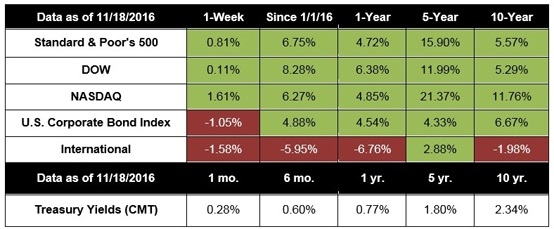STOCKS UP, FED INCREASE LIKELY
For the second straight week, the major domestic indexes all ended in positive territory: The S&P 500 was up 0.81%, the Dow increased 0.11%, and the NASDAQ added 1.61%.[1] While American indexes performed well, MSCI EAFE’s international equities declined 1.58%.[2]
With the long, drawn-out presidential election behind us, investors are beginning to look past politics and pay closer attention to the economic fundamentals.[3] As we’ve shared in recent market updates, the economy shows many signs of strength and growth. In the past few weeks alone:
- GDP beat expectations.[4]
- Hourly earnings increased.[5]
- The Dow reached an all-time high.[6]
- New unemployment claims hit a 43-year low.[7]
- Housing starts increased 25.5%.[8]
Of course, the economy is far from perfect – and growth is still slower than we’d like – but the overarching message is that the economy is doing well.
Thus, we were not surprised this week when Federal Reserve Chair Janet Yellen said an interest rate hike “could well become appropriate relatively soon.”[9] Despite what talking heads might warn on television, you should not be afraid of increasing interest rates.
The last increase, which took place in December 2015, may have contributed to the volatility we experienced at the beginning of this year. However, the markets have certainly recovered from their momentary stumble – with all major domestic indexes posting at least 6% increases year to date.[10]
Volatility could increase for a short time after the next interest rate increase, but it also may not. Right now, we see the markets reacting positively despite a 90% chance of the Fed increasing rates next month.[11]
In other words, we believe investors are seeing a potential rate increase as the good news that it is, because it indicates faith in our economy. When Yellen and the Fed decide to raise rates, they are demonstrating belief that the economy is strong enough to move back toward historically normal levels.
We’ve become so accustomed to this post-recession rate world that it’s easy to forget just how unusually low our current 0.5% rate is.[12] Even if we move to 0.75% next month, borrowing money is still incredibly inexpensive, and we have additional room for future increases.
We are heartened to see the economy continue to grow, and President-Elect Trump’s policies may quicken the pace beyond what we’ve experienced in the recovery so far. Of course, as we’ve seen many times this year, a likely outcome isn’t the same as a guaranteed one, so we’ll have to wait and see what the Fed decides in December.
In the meantime, we encourage you to look beyond pundits’ histrionics and headlines to see that our economy is strengthening. We are here to help you make the most of it.
ECONOMIC CALENDAR:
Tuesday: Existing Home Sales
Wednesday: Durable Goods Orders, New Home Sales, Consumer Sentiment
Thursday: Markets Closed for Thanksgiving
Friday: International Trade in Goods

Notes: All index returns exclude reinvested dividends, and the 5-year and 10-year returns are annualized. Sources: Yahoo! Finance, S&P Dow Jones Indices and Treasury.gov. International performance is represented by the MSCI EAFE Index. Corporate bond performance is represented by the SPUSCIG. Past performance is no guarantee of future results. Indices are unmanaged and cannot be invested into directly.
These are the views of Platinum Advisor Marketing Strategies, LLC, and not necessarily those of the named representative, Broker dealer or Investment Advisor, and should not be construed as investment advice. Neither the named representative nor the named Broker dealer or Investment Advisor gives tax or legal advice. All information is believed to be from reliable sources; however, we make no representation as to its completeness or accuracy. Please consult your financial advisor for further information.
Investing involves risk including the potential loss of principal. No investment strategy can guarantee a profit or protect against loss in periods of declining values.
Diversification does not guarantee profit nor is it guaranteed to protect assets.
International investing involves special risks such as currency fluctuation and political instability and may not be suitable for all investors.
The Standard & Poor’s 500 (S&P 500) is an unmanaged group of securities considered to be representative of the stock market in general.
The Dow Jones Industrial Average is a price-weighted average of 30 significant stocks traded on the New York Stock Exchange and the NASDAQ. The DJIA was invented by Charles Dow back in 1896.
The Nasdaq Composite is an index of the common stocks and similar securities listed on the NASDAQ stock market and is considered a broad indicator of the performance of stocks of technology companies and growth companies.
The MSCI EAFE Index was created by Morgan Stanley Capital International (MSCI) that serves as a benchmark of the performance in major international equity markets as represented by 21 major MSCI indices from Europe, Australia and Southeast Asia.
The S&P U.S. Investment Grade Corporate Bond Index contains U.S.- and foreign-issued investment-grade corporate bonds denominated in U.S. dollars.
The SPUSCIG launched on April 09, 2013. All information for an index prior to its Launch Date is back-tested, based on the methodology that was in effect on the Launch Date. Back-tested performance, which is hypothetical and not actual performance, is subject to inherent limitations because it reflects application of an Index methodology and selection of index constituents in hindsight. No theoretical approach can take into account all of the factors in the markets in general and the impact of decisions that might have been made during the actual operation of an index. Actual returns may differ from, and be lower than, back-tested returns.
The S&P/Case-Shiller Home Price Indices are the leading measures of U.S. residential real estate prices, tracking changes in the value of residential real estate. The index is made up of measures of real estate prices in 20 cities and weighted to produce the index.
The 10-year Treasury Note represents debt owed by the United States Treasury to the public. Since the U.S. Government is seen as a risk-free borrower, investors use the 10-year Treasury Note as a benchmark for the long-term bond market.
Opinions expressed are subject to change without notice and are not intended as investment advice or to predict future performance.
Past performance does not guarantee future results.
You cannot invest directly in an index.
Consult your financial professional before making any investment decision.
Fixed income investments are subject to various risks including changes in interest rates, credit quality, inflation risk, market valuations, prepayments, corporate events, tax ramifications and other factors.
By clicking on these links, you will leave our server, as they are located on another server. We have not independently verified the information available through this link. The link is provided to you as a matter of interest. Please click on the links below to leave and proceed to the selected site.
- http://finance.yahoo.com
http://finance.yahoo.com
http://finance.yahoo.com - https://www.msci.com/
- http://www.cnbc.com
- http://www.marketwatch.com
- http://www.ftportfolios.com/Commentary
- http://www.cnbc.com
- http://www.bloomberg.com
- http://www.ftportfolios.com/Commentary
- http://www.bloomberg.com
- http://finance.yahoo.com
http://finance.yahoo.com
http://finance.yahoo.com - http://www.cnbc.com
- http://www.tradingeconomics.com/






